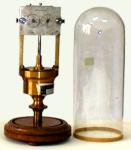 Menu
Menu
|
Function It is used to draw the vibration of the tuning fork. |

| ||
|
|||
|
Description We blacken a glass plate with lampblack. We vibrate the tuning fork leaning its point on the glass plate. | |||
|
Function To show the modes of a vibrant plate. |

| ||
|
|||
|
Description A brass chuck is fixed on a heavy basis. The glass or brass plates are fixed to the chuck for the experiments in the vibrating plates. Once the plate is fixed and strew with fine sand, it is made to vibrate with a violin bow, so that we obtain interference patterns | |||
|
Function It produces sounds tuned one with the other. |

| ||
|
|||
|
Description Also this apparatus is an accessory of the rotary apparatus. It is formed by four brass disks with pointed isosceles gear teeth in numbers of 80, 60, 50, 40, fitted on the same axe that ends with a cone. If the wheels rotate with a uniform motion, by drawing a thin cardboard near the gear teeth, we have vibrations proportional to the numbers 8, 6, 5, 4 and the corresponding sounds are perfectly tuned. | |||
|
Function We can obtain sound with different frequencies. |

| ||
|
|||
|
Description Model with revolution counter spring start and stop instantaneously. To keep the sound pitch given by the siren constant, it is necessary to have bellows with a pressure regulator. The number of complete vibrations, that corresponds to the emitted sound, is given by the product of the number of the holes by the number of the turns divided by the duration of the sound in seconds. | |||
|
Function To show that sound does not propagate in the vacuum. |

| ||
|
|||
|
Description It is a glass balloon that can be connected to a pneumatic pump. In this balloon there is a bronze bell, connected to the metallic escutcheon with a low sound conductivity substance (skin, rubber). The intensity of the sound decreases when the pressure decreases. | |||